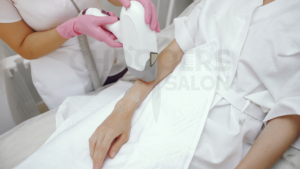Rosacea is a common skin condition characterized by facial redness, flushing, and visible blood vessels. It can cause discomfort and self-consciousness for those affected. Photo facial, also known as intense pulsed light (IPL) therapy, has shown promising results in treating rosacea and reducing facial redness. This article will explore how photo facial works to target rosacea and redness, the benefits of this treatment, and its potential considerations.
Treating Sun Damage and Age Spots:
One of the primary uses of photo facials is to treat sun damage and age spots caused by prolonged sun exposure. The intense light energy emitted during the treatment is absorbed by the targeted pigmented areas, such as freckles, sunspots, and discoloration. This absorption of light leads to the breakdown of pigmented cells, ultimately reducing the appearance of sun damage and age spots. Over a series of treatments, photo facials can significantly improve skin tone and restore a more youthful complexion.
Addressing Hyperpigmentation:
Hyperpigmentation refers to the darkening or uneven distribution of pigment in the skin. It can occur due to various factors, such as hormonal changes, acne scarring, or excessive sun exposure. Photo facial works by selectively targeting the excess melanin in the skin responsible for hyperpigmentation. The light energy is absorbed by the melanin, which helps break down the pigmented cells and fade the dark spots. As a result, photo facials can effectively minimize hyperpigmentation and promote a more even skin tone.
Treating Vascular Lesions:
Vascular lesions, including spider veins, broken capillaries, and rosacea, can be effectively treated with photo facials. The light energy emitted during the treatment is absorbed by the hemoglobin in the blood vessels, causing them to coagulate and shrink. This process reduces the visibility of vascular lesions, resulting in a clearer and more even complexion. Photo facials can also help alleviate the redness and inflammation associated with rosacea, providing relief to individuals with this skin condition
Understanding Photo Facial for Rosacea Treatment:
Photo facial utilizes intense pulses of light to target and treat specific skin concerns, including rosacea. The light energy is absorbed by the hemoglobin in the blood vessels, which causes them to coagulate and shrink. This process helps reduce the appearance of facial redness and visible blood vessels associated with rosacea. Additionally, photo facial stimulates collagen production, which can improve skin texture and overall skin health.
Benefits of Photo Facial for Rosacea Treatment:
Reduces Facial Redness:
One of the primary benefits of photo facials for rosacea treatment is their ability to reduce facial redness. By targeting the dilated blood vessels responsible for the redness, photo facials can significantly diminish the appearance of flushed skin.
Minimally Invasive:
A photo facial is a non-invasive procedure that does not require incisions or needles. The treatment is generally well-tolerated, and most individuals can resume their normal activities immediately after the session.
Improves Skin Texture:
In addition to reducing redness, photo facials can improve skin texture. The stimulation of collagen production helps to tighten the skin, reduce fine lines, and enhance overall skin tone and smoothness.
Customizable Treatment:
In addition to reducing redness, photo facials can improve skin texture. The stimulation of collagen production helps to tighten the skin, reduce fine lines, and enhance overall skin tone and smoothness.
Considerations for Photo Facial Treatment:
Multiple Sessions:
Achieving optimal results often requires a series of photo-facial sessions. The number of sessions needed depends on the severity of the rosacea and the individual s response to the treatment.
Potential Side Effects:
While photo facial is generally safe, there may be temporary side effects such as redness, swelling, or mild discomfort immediately after the treatment. These effects typically subside within a few hours or days.
Maintenance and Sun Protection:
To maintain the results of photo facial treatment, it is important to follow a consistent skincare routine and protect the skin from sun exposure. Sunscreen with a high SPF should be used daily, and avoiding excessive sun exposure can help prevent rosacea flare-ups.
Conclusion:
Photo facial offers a promising solution for individuals seeking relief from rosacea and facial redness. Its ability to target dilated blood vessels and stimulate collagen production can result in a significant reduction in redness and improved skin texture. However, it is essential to consult with a qualified skincare professional to determine if photo facial is suitable for individual needs and to develop a personalized treatment plan. With proper care and regular maintenance, photo facials can be a powerful tool in treating rosacea and restoring a more even-toned complexion.
FAQs (frequently-asked questions)
Rosacea is a chronic skin condition that primarily affects the face, causing redness, visible blood vessels, and often, small red bumps.
Photofacial treatments can target the excess blood vessels and redness associated with rosacea, providing a reduction in symptoms.
Photofacial treatment is effective for many types of rosacea, but a consultation with a dermatologist or skincare professional is recommended to determine suitability.
Multiple sessions, usually spaced a few weeks apart, are often necessary to achieve the desired reduction in redness.
Some mild redness and swelling can occur after treatment, but these effects are generally temporary and subside within a day or two.
While photo facials can significantly reduce the redness and symptoms of rosacea, it’s unlikely to provide a complete cure.
The results can be long-lasting, but maintenance sessions might be needed to sustain the improvements over time.
When performed by a qualified professional, photo facial treatments are usually well-tolerated and can improve rosacea symptoms.
Temporary redness and mild swelling are common side effects, but severe complications are rare when the treatment is performed by a trained practitioner.
Your dermatologist or skincare professional can guide you on combining treatments for optimal results, as part of a comprehensive plan for managing rosacea.




